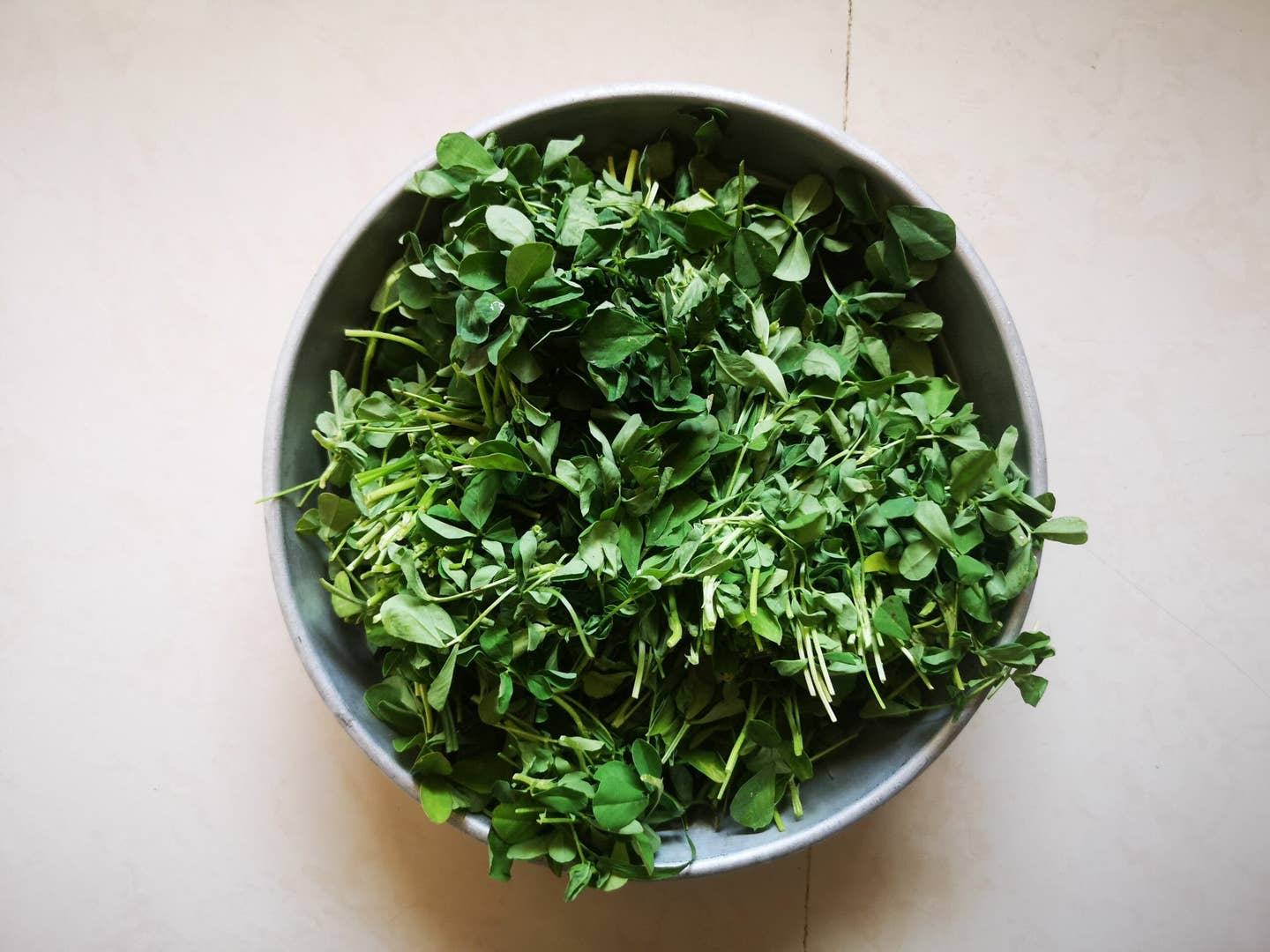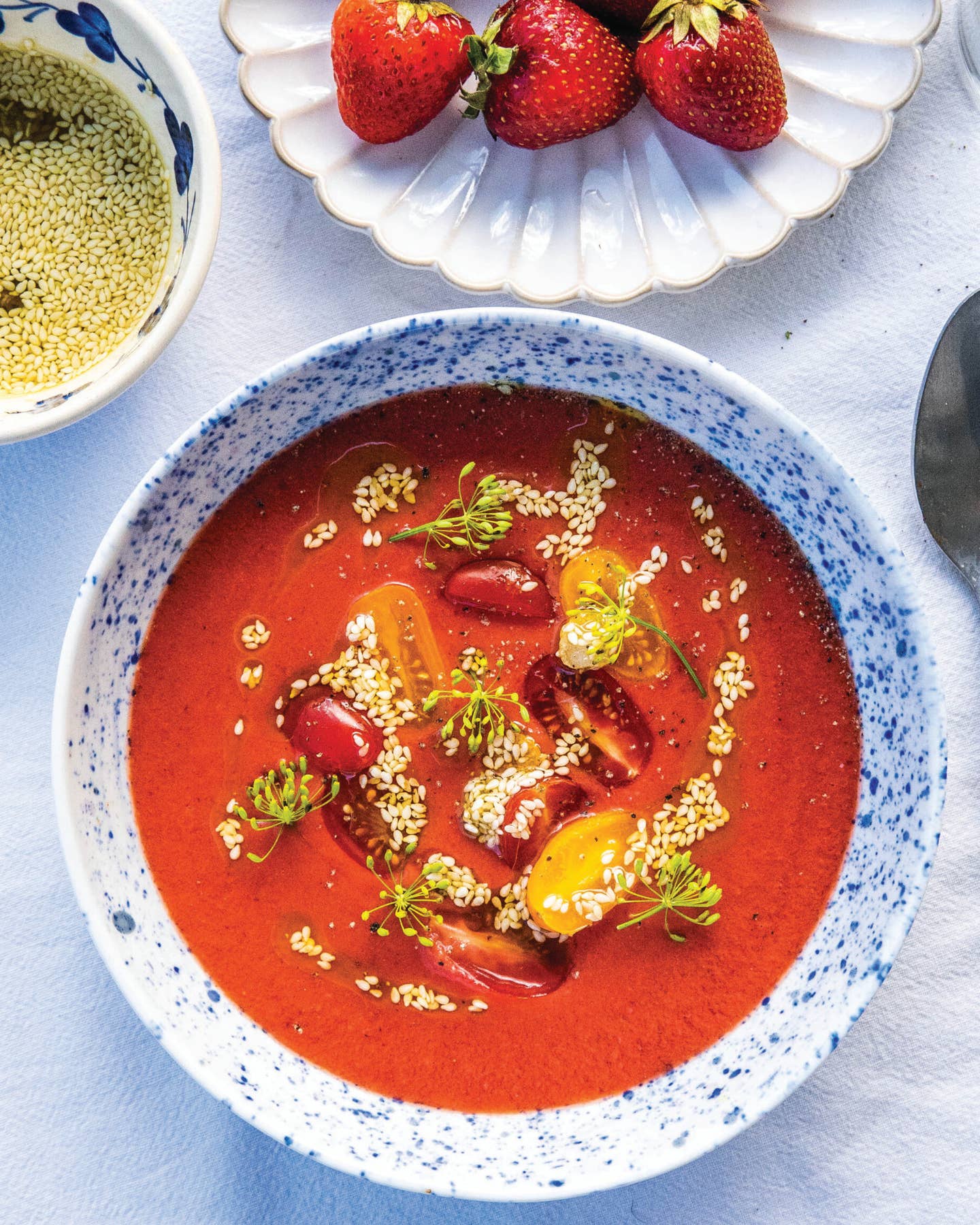
India’s Beautifully Bitter Flavors
The subcontinent’s many bracing ingredients are essential to its cultures, cuisines, and traditional medicines—and deserve a prime spot in your pantry.
Many bitter foods have been cast out of the good graces of the Western world, but not in India, where all are afforded parity in the country's culinary landscape.
No matter where you go in the subcontinent, bitterness is grained deep into the culture. Fenugreek seeds and leaves (both fresh and dried into kasuri methi), bitter gourd, spinach, guar beans, papdi (hyacinth bean), and vaal (field beans) are staples, but you will also find the leaves of the neem plant, night jasmine, pointed gourd, and amaranth, amongst others. It is likely that this affinity grew spontaneously; many plants, such as the bitter gourd, the neem, and the guar bean are indigenous to the country. Ayurveda also had a hand to play.
Across India, bitter foods are friend and salve, powerhouses of nutrients, and often rich in fiber. Sometimes, the health is besides the point; the brace of bitterness that sluices our taste buds is these ingredients’ most enduring appeal.
Indians consider bitterness a crucial building block of flavor. Sometimes it stands in solitude without any accompaniment, as with a finely-sliced bitter gourd or with neem leaves, spiced and deep-fried to crisp. Other times, it is one within a symphony of flavor, as with the tenebrous acridity of papri (hyacinth beans) piercing unctuous, ghee-steeped mutton kebabs. Sometimes, it works the other way round, the bitterness of toasted fenugreek seed puncturing the monochrome sweetness of a vegetable like pumpkin. Bitterness has so many shades and partners; each community finds its own way.
Even a cursory mapping of ancient Indian writings shows that bitter foods are unshiftably ensconced in the Indian kitchen. The first in this roll call of texts is bitter gourd, mentioned in the Vedas as well as in Jain literature that stretches back to 400 BCE. The gourd has even inspired febrile flights of fancy: the Ksemakutuhalam (a 1550 Sanskrit treatise on diet and health) refers to that vegetable as “an emerald without and a coral within.” Similarly, our dalliance with fenugreek goes way back. Native to southern Europe and mentioned in literature written as far back as 800 BCE, remnants of the plant have even been excavated from the littered ruins of Harappa, a South Asian Bronze Age civilization that flowered around 4,500 years ago.
"But bitter foods are perhaps most reified by Ayurveda; a philosophy that holds resonance with some Indians even today."
But bitter foods are perhaps most reified by Ayurveda; a philosophy that holds resonance with some Indians even today. Ayurveda looks at the pantry as pharmacopeia, believing that when the humors become imbalanced, they lead to disease (this is contested of course by modern medicine). “The treatments using food are based on the six tastes (‘rasa’ in Sanskrit)—sweet, sour, salty, pungent, bitter and astringent,” writes restaurateur Camellia Panjabi in The Great Curries of India... Foods with bitter taste eliminate bacterial elements, purify the blood and are light on digestion.” This purported ease of digestion makes these ingredients popular summer or monsoon-season foods.
For tongues that might find bitter flavors aberrant, consider these simple dishes as an entry point, before abseiling into the cavernous repertoire of bitter vegetable recipes.
Steep finely sliced bitter gourd or spinach leaves in a gram flour batter, then deep fry until the fritters grow gold and crisp. Work chopped fenugreek leaves into paratha dough (then mix and match your methi paratha with knobs of your favorite pickle and a scoop of fresh yogurt.) Or you might sauté some spinach or fenugreek leaves with tomato, onion, turmeric and chili powder until they wrinkle, then fork them into a cup of cooked toor dal. When confronted with sweetness, bitterness yields its belligerence. Maharashtrian fenugreek curry, for example, pools vaal beans with coconut, kokum fruit, and jaggery. Caramelized onions perform the same function for the Kayasth community's bharwa karela (lightly browned onions stuffed in the cleft of a whole bitter gourd), as does the oblique sweetness of coconut flesh, by way of Kerala's pavakkai (bitter gourd) thoran.
Meat mates well with it too. Sadia Dehlvi writes about the conviviality shared between bitter gourd and ground lamb (“qeema” or "keema" or "kheemo") in her book Jasmines and Jinns: “Karela qeema is my favourite qeema and I make it all through the summer months, when karela and raw mango are in plenty...Most friends try it for the first time in my home and seem to love it." Similarly, the Parsi community tames the bellicosity of the bitter papri (hyacinth bean) and its seeds with minced mutton kebabs, which are dipped in egg and breadcrumbs, then fried.
Less commonly, bitterness is constrained with legumes, as with the Maharashtrian methichi usal (sprouted fenugreek curry), which marries fenugreek seeds with toor dal (pigeon peas), jaggery, and coconut. Sometimes, bitterness is just a spectral taste, like in a lime peel pickle tasselled with salt and spice.
For those who wish it, there are many ways to flush the bitterness from a plant: a trickle of salt or a long soak in brine usually helps. But mostly the triumph of a bitter dish comes through its accompaniments. Each dish must have a companionable balance of flavors, rather than a jostle of contrapuntal tastes thrown together pell-mell. Bitterness acts as a fine foil to the pucker of acidity, the sting of salt, and the plush of sweetness.
But often, the bitterness is the point of a dish—a taste to be treasured on its own, uneroded by palliating flavors.
Parsis do nothing to allay the bite of fenugreek leaves in their bhaji dana; they choose the small-leaved varieties, then cook it with a splatter of green peas. The greens are shot through with ginger-garlic paste, flayed with chile, then gentled with caramelized onions. The more carnivorous might also fork in pieces of mutton to make bhaji dana ma gos. In Assam, teetaphool (orange-crimson bitter flowers) are tossed in batter and crisp-fried. In Bengal, bitterness is almost a cultural signifier; few communities are as prodigious eaters of bitter foods as the Bengalis. In Bengali Cooking: Seasons and Festivals, Chitrita Banerji writes about how belief in the specific attributes of different foods has long flourished in Bengal “because of a long tradition of Ayurvedic medicine practised by local physicians....The association of healthy properties with a bitter taste and the subsequent appreciation of that bitterness as a taste is a Bengali peculiarity that outsiders find incomprehensible.” She also credits its popularity to the charismatic Bengali founder of the vegetarian equality-and-non-violence-driven Bhakti movement, Chaitanya, who was fond of dishes containing shukuta (dried neem leaves). There are so many bitter Bengali recipes: neembegun (eggplant fried with neem leaves), tetor dal (mung dal with crisped bitter gourd), ucche bhaja (fried rings of bitter gourd). But perhaps the best known one is the shukto.
Shukto is a mixed vegetable dish eaten as a sort of starter for the midday meal. “Shukto's unique value is based on the gastronomic theory that it prepares the tongue and stomach for the courses that follow,” Banerji writes. It is a covenant of reciprocity, the bitterness of the gourd (or neem leaves, or patol, the climbing gourd) palliated with eggplant, white radish, green banana, potato, green papaya, or even fish. Shukto offers tremendous leeway, yet each ingredient must serve to edify the other. Only an experienced cook can know the exact pitch of bitterness that makes an excellent shukto, that “balance between the bitterness of the vegetables and the seasonings, which include ground ginger, poppy-seed paste, and the typical Bengali five-spice mix called panch phoron,” as Banerji notes. Ghee, the final tile in the mosaic, is spooned in just before the dish is lifted from the flames.
“You won't find shukto coexisting with chicken tikka masala in Indian restaurants abroad,” writes Banerji. “Even in Bengal, it is essentially a home-cooked item.” And so it is with all these dishes. It isn't restaurant food, tweezered and bowdlerized to make it palatable to the coddled tongue. Bitter foods resist conformity; they refuse to be constrained by the choke-collar of popular opinion with its bias towards sour, savory, and sweet flavors. They are aberrant pockets of comfort, Banerji writes in The Hour of the Goddess, “the perfect representation of the intersection of tastes, which lends mystery and delight to food.”
Recipes
This recipe will quickly convert bitter gourd haters to fans. Get the recipe for Parsi-style Karela Ma Kheemo »
Eat this highly versatile dish of fenugreek leaves on its own, with a cooked egg on top, or as a side dish with chicken or lamb. Get the recipe for Bhaji Dana »
Keep Reading
Continue to Next Story










